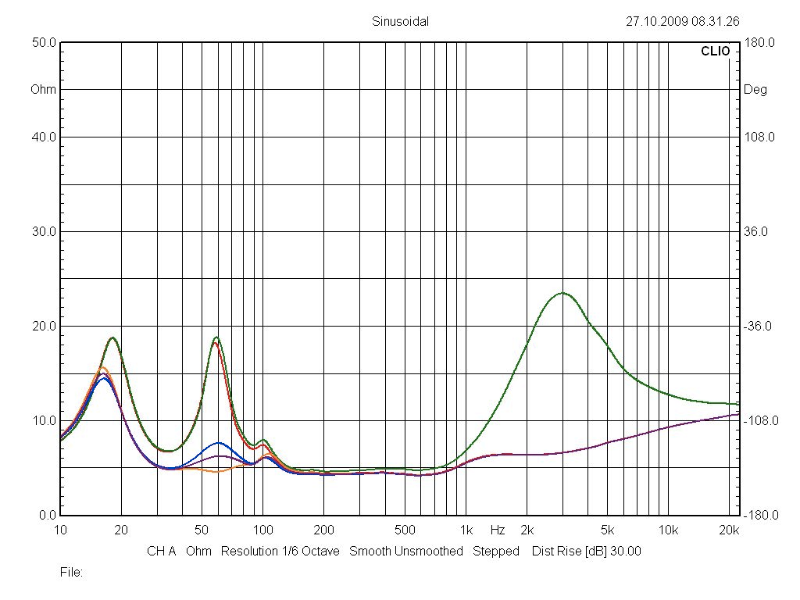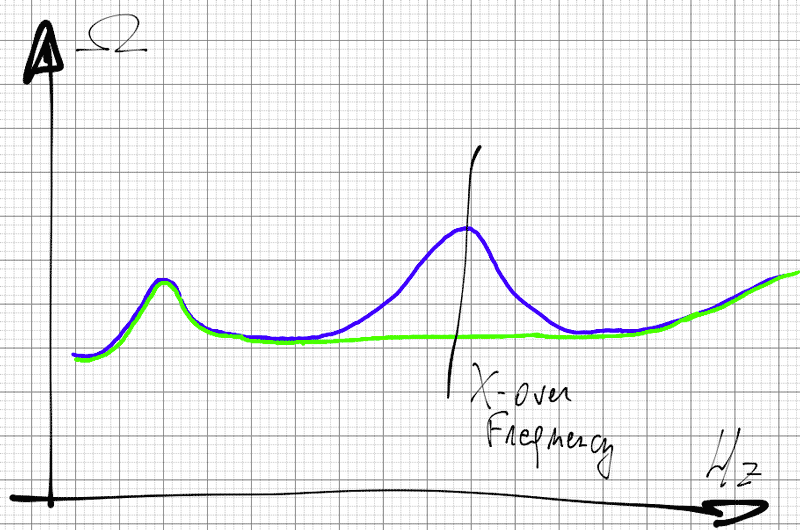Impedance linearisation
Impedanzlinearisierung
Linearizzazione di impedenza

- Green: Impedance without linearization,
- Orange: Impedance with cross over impedance linearization but without Low frequency-impedance linearization
- Blue: low frequency impedance linearization put on Low
- Purple: low frequency impedance linearization put on Medium
- Yellow: low frequency impedance linearization put on High
The cross-over impedance linearization is in our experience useful on all tube amplifiers (some people prefer to keep it switched off - question of taste and overall system).
The Bass impedance linearization leads to higher definition and better control in the low frequencies. The fact is that only rare tube and hybrid power amplifier need it, suggests us not to stress the construction to achieve this result.
In fact, each improvement is only useful, as long as the drawback it brings, is smaller than the problem it corrects
- Grün: Impedanzverlauf OHNE Impedanzlinearisierung
- Orange: Impedanzverlauf mit zugeschalteter Impedanzlinearisierung beim Übergang, OHNE Bass-Impedanzlinearisierung
- Blau: Bass-Impedanzlinearisierung auf Low
- Violett: Bass-Impedanzlinearisierung auf Medium
- Gelb: Bass-Impedanzlinearisierung auf High
In der Tat, jede Verbesserung ist nur nützlich, solange die Nachteile kleiner sind als die Fehler, die sie korrigiert
- Verde: curva senza linearizzazione
- Arancio: Impedenza con la linearizzazione nelle frequenze di cross-over inserita, ma senza la linearizzazione nel basso
- Blu: linearizzazione d'impedenza del basso in posizione Low
- Rosso: linearizzazione d'impedenza del basso in posizione Medium
- Giallo: linearizzazione d'impedenza del basso in posizione High
La linearizzazione nel campo di taglio è utile a nostro avviso su tutti i valvolari. La linearizzazione nel basso invece non è sempre necessaria, per questo abbiamo deciso di non stressare il progetto introducendo anche questo cambiamento
La linearizzazione del basso da maggiore definizione ed un migliore controllo nelle basse frequenze.
In fondo, ogni miglioramento è un miglioramento solo finché gli errori aggiuntivi che porta sono minori del vantaggio che dà.
Theory behind
Die Theorie
La teoria

-----------Start Quote from ePanorma.net----------- Read more here about this thema
-----------End Quote from ePanorma.net-----------There is a convention to the use of the term "nominal impedance", and if the impedance over the majority of the bandwidth, specifically covering the range in spectrum where majority of the musical spectral power occurs, it's 8 ohms. A single number cannot tell all there is to tell about an impedance that varies with frequency. You must keep in mind that 'nominal impedance' is not defined in IEC. Indeed, the electronics industry was advised when the Trade Descriptions Act was introduced, that the word 'nominal' should no longer be used in specifications. That is why the IEC concept of 'rated value' is so useful. There is a very detailed definition and explanation of this term in IEC60268-2. The IEC standard (IEC60268-3) allows any "increase" above the rated value, but limits the "decrease". The standard does not allow the impedance to fall below the 80 % of the nominal value at any frequency, including DC.
Saying that there is a nominal resistance of 8 Ω, does not mean that the impedance is flat 8Ω over the whole frequency spectrum.
One critical range is at the cross over frequency, where normally there is a peak (blue curve in the drawing). Therefore we developed and implemented in our loudspeakers a switchable impedance linearization for the cross over frequency. This flattens the impedance curve in the critical range (green curve in the drawing).
-----------Aus der Seite von ePanorma.net----------- Hier konnen sie mehr über dieses Thema lesen
-----------Ende from ePanorma.net-----------There is a convention to the use of the term "nominal impedance", and if the impedance over the majority of the bandwidth, specifically covering the range in spectrum where majority of the musical spectral power occurs, it's 8 ohms. A single number cannot tell all there is to tell about an impedance that varies with frequency. You must keep in mind that 'nominal impedance' is not defined in IEC. Indeed, the electronics industry was advised when the Trade Descriptions Act was introduced, that the word 'nominal' should no longer be used in specifications. That is why the IEC concept of 'rated value' is so useful. There is a very detailed definition and explanation of this term in IEC60268-2. The IEC standard (IEC60268-3) allows any "increase" above the rated value, but limits the "decrease". The standard does not allow the impedance to fall below the 80 % of the nominal value at any frequency, including DC.
Wenn man eine Nennimpedanz von 8Ω hat, bedeutet das längst noch nicht, dass sie auch ebenmässig über den gesamten Frequenzbereich verläuft. In der Regel gibt es kritische Bereiche - einer davon ist die Übergangsfrequenz, die ein Maximum aufweist (blaue Kurve in der Zeichnung). Deswegen haben wir eine Impedanzlinearisierung entwickelt und eingeführt. Sie ist zuschaltbar für die Übergangsfrequenz. Das flacht die Impedanzspitze bei der Trennfrequenz ab (grüne Linie).
-----------Quota da ePanorma.net----------- Per aver maggiori informazioni, leggete quì.
-----------Fine della quota da ePanorma.net-----------There is a convention to the use of the term "nominal impedance", and if the impedance over the majority of the bandwidth, specifically covering the range in spectrum where majority of the musical spectral power occurs, it's 8 ohms. A single number cannot tell all there is to tell about an impedance that varies with frequency. You must keep in mind that 'nominal impedance' is not defined in IEC. Indeed, the electronics industry was advised when the Trade Descriptions Act was introduced, that the word 'nominal' should no longer be used in specifications. That is why the IEC concept of 'rated value' is so useful. There is a very detailed definition and explanation of this term in IEC60268-2. The IEC standard (IEC60268-3) allows any "increase" above the rated value, but limits the "decrease". The standard does not allow the impedance to fall below the 80 % of the nominal value at any frequency, including DC.
Dire che il diffusore ha un'impedenza nominale di 8Ω, non significa che l'impedenza sia piatta ad 8Ω lungo tutto l'arco delle frequenze. Una zona critica è la zona di taglio. Di norma in corrispondenza di essa c'è un picco (curva blu del disegno). Per questo motivo abbiamo sviluppato ed implementato nei nostri diffusori una linearizzazione d'impedenza eliminabile per la frequenza di taglio. L'uso di questo modulo permette di appiattire la curva dell'impedenza in base alla frequenza (curva verde nel disegno) rendendo così questo valore ancora più costante.